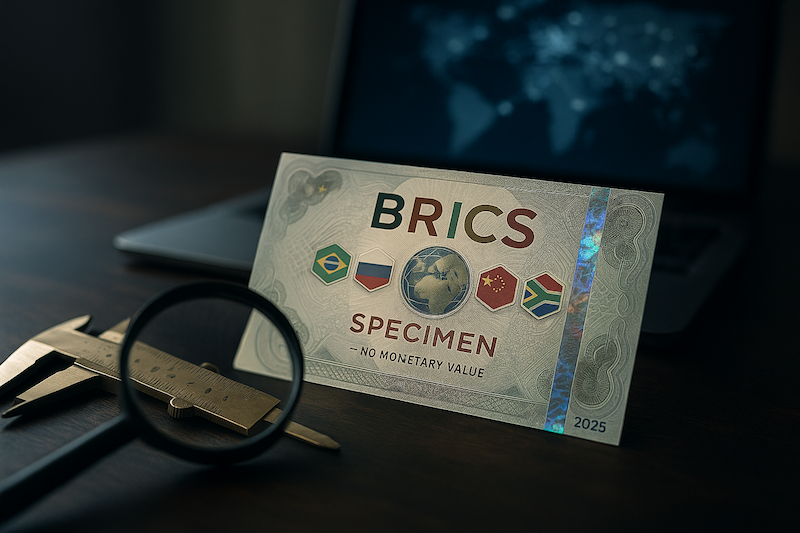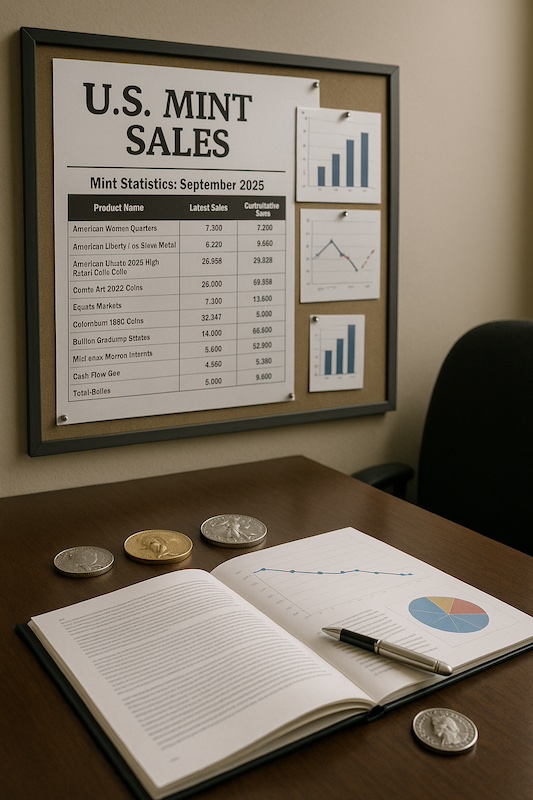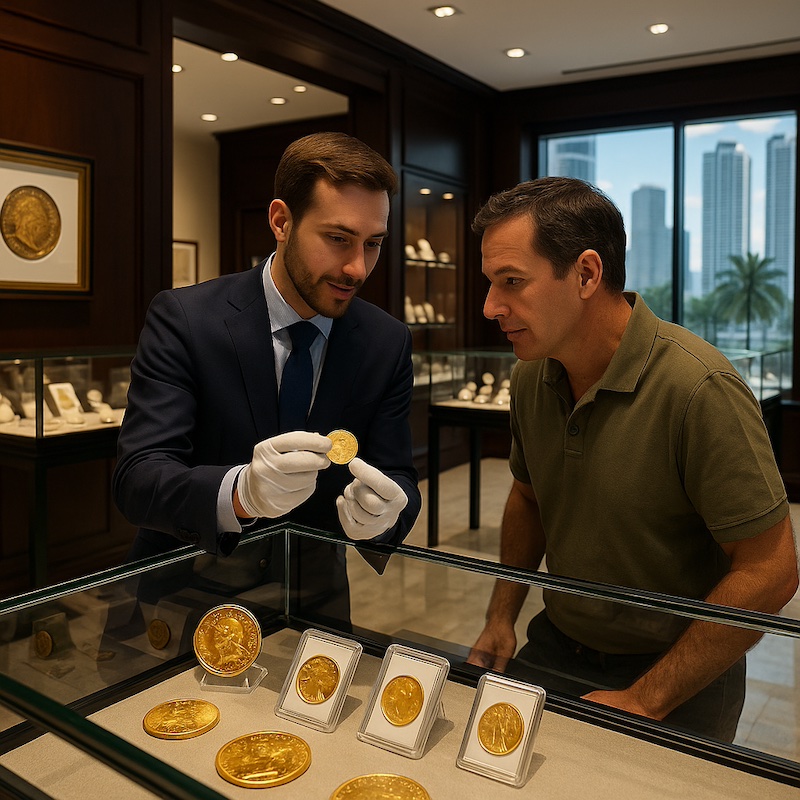Hook: Ten thousand sample BRICS currency banknotes quietly circulated at a July 2025 summit in Russia—souvenir pieces with no face value, but a bold message: the bloc is thinking seriously about a shared monetary future. For numismatists, that’s a potential new collecting frontier; for coin industry professionals and investors, it’s a signal about payment systems, reserves, and where the market narrative might be headed.
“The talk of a BRICS currency isn’t just about notes and coins—it’s about plumbing: settlement rails, legal tender status, and governance,” as one central-bank technologist summed it up to me recently. That’s the right lens for assessing both collecting value and macro risk/reward.
Below, we break down what’s real, what’s rumor, and how to position as a collector or market participant—with data, context, and balanced, well-sourced guidance.
TL;DR (for quick readers)
- What happened: 10,000 symbolic BRICS banknotes were distributed in July 2025 to show what a future currency could look like; they are not legal tender.
- Where it’s going: Instead of a near-term shared currency, BRICS is prioritizing cross-border payment systemsand local-currency settlement; leaders also affirmed India will host the 2026 summit.
- Macro reality check: The U.S. dollar still accounts for about 57.7–57.8% of global FX reserves (Q4 2024–Q1 2025) and dominates payments; the yuan’s SWIFT share was about 2.9–4% in mid-2025. A wholesale displacement is unlikely soon.
- Collector angle: These BRICS “notes” are best considered fantasy/souvenir issues, potentially collectable as ephemera—not monetary instruments. Use PMG/IBNS guidance when evaluating.
Why the BRICS currency story matters now
The July 2025 Rio de Janeiro BRICS Leaders’ Declaration put payment rails on the agenda—calling for “fast, low-cost, more accessible” cross-border payments. That’s consistent with the bloc’s longer-running desire to reduce dependence on Western financial infrastructure. India will chair the 2026 summit, giving another focal point (and timeline) to watch.
At the same time, reports from the summit circuit and national media highlight an expanded BRICS membership now commonly counted as ten, including Indonesia alongside Brazil, Russia, India, China, South Africa and the 2024 additions Egypt, Ethiopia, Iran, and the UAE (Saudi Arabia’s status has fluctuated in reports, but Reuters has flagged the formalities as unresolved earlier in 2025). This broader tent may increase ambition—while complicating execution.
Key takeaway: The narrative has momentum, but the mechanics are complex. For collectors and investors, that split—between symbolism and infrastructure—creates both story-driven demand and headline risk.
What actually exists today: souvenir notes, not money
Multiple outlets, including numismatic media, reported that 10,000 sample BRICS notes were printed and distributed as demonstration pieces—no legal-tender status in any member country. In the language of notaphily, these are closer to fantasy or souvenir issues, like expo souvenirs or concept pieces. That doesn’t make them uncollectable—it just places them firmly in ephemera rather than in monetary history (at least for now).
- Definition check: A fantasy issue resembles money but is privately made and not legal tender; collectors treat them as curiosities or art, not circulating currency.
- Best practice: If you buy or appraise such items, lean on PMG standards for authentication and grading procedures, and the IBNS for collecting frameworks and terminology.
Numismatic implications
- Scarcity & demand: 10,000 pieces is not ultra-scarce, but named, well-documented issues tied to a major geopolitical storyline can become niche collectibles. Provenance and documentation will matter.
- Authentication: Expect reproductions and look-alikes; rely on third-party grading where appropriate to avoid misrepresentation.
- Ethical listing: Accurately describe them as non-legal tender and demonstration/souvenir notes.
Payment rails first, “BRICS currency” later (if ever)
The more immediate BRICS push is for alternative cross-border payment systems, not a single shared currency. Russian and Brazilian officials, as well as the Rio Declaration language, emphasize settlement systems that use local currencies and potentially digital rails.
In parallel, the BIS is advancing Project mBridge, a multi-CBDC platform (with Hong Kong, China, Thailand, and the UAE) that recently entered an MVP phase to test real-value cross-border payments. BIS’s Agustín Carstens has played down sanctions-busting narratives: mBridge “is not mature enough” and is not designed for evasion—a reminder that plumbing, not geopolitics, is the official selling point.
What this means for markets: Expect incremental change—better settlement links among BRICS+ economies—before any credible move toward a single unit of account.
Macro context: the U.S. dollar still dominates—by a lot
If a BRICS currency is intended to rival the dollar, the hill is steep:
- Reserves: The dollar’s share of global FX reserves was about 57.8% in Q4 2024 and 57.7% in Q1 2025, per IMF COFER data (via Reuters). The euro was ~19.8–20.1%; the renminbi about 2.2%. Trends show a slow diversification, not a collapse.
- Payments: In June 2025, SWIFT data show the yuan at ~2.88% of global payments; other analyses put it around 4% on some measures—still far behind the USD.
- IMF view: The Fund calls it a “stealth erosion” of dollar dominance—gradual diversification into non-traditional currencies—not a rapid dethroning.
Investor takeaway: Any de-dollarization story is a multi-year arc. Portfolio decisions should reflect measured probabilities, not headlines.
Comparing the options (collector & investor lens)
| Feature | Proposed BRICS currency | U.S. dollar | Euro |
|---|---|---|---|
| Legal-tender status | None (concept only; July 2025 sample notes are souvenirs) | Global reserve anchor | Second-largest reserve |
| Share of global FX reserves | N/A | ~57.7–57.8% (Q4 ’24–Q1 ’25) | ~19.8–20.1% |
| SWIFT payments share (mid-2025) | N/A | #1 by wide margin | #2 |
| Existing payment rails | BRICS settlement ideas; BRICS Pay talk; focus on local currencies and digital rails | CHIPS, Fedwire, dollar-denominated stablecoin ecosystems | TARGET2, SEPA; Digital euro in exploration |
| Near-term outlook | Payment systems first; currency unlikely before deep policy convergence | Dominant but slowly diversifying environment | Stable second, digital euro exploration |
Where collectors might find value (and where to be cautious)
Opportunities
- Documented ephemera: Early concept/souvenir issues linked to major events often become desirable references in future catalogues. Seek clear provenance.
- Official commemoratives: If BRICS members issue national commemorative coins or medals tied to milestones (summits, payment-system launches), those legal-tender pieces may see collector and crossover demand. (Watch India’s 2026 chairship for mint products.)
- Error and variety appeal: Should any officially sanctioned notes or medals emerge later, error types and specimen issues frequently command premiums. Use PMG/IBNS guidance.
Risks
- Overpaying for fantasy: Souvenir notes are not money. Price them like ephemera, not like sovereign banknotes.
- Authentication pitfalls: Anticipate replicas and marketing hype. Verify with third-party grading and conservative attributions.
- Liquidity: Niche items can be thinly traded; plan for longer holding periods.
Balanced outlook: pros, cons, and what to watch
Potential benefits
- Lower frictions intra-BRICS: Better cross-border settlement can cut costs and improve trade efficiency.
- Diversification narrative: For reserve managers and corporates, more options—including RMB linkages and multi-CBDC corridors—can reduce single-point dependencies.
Key constraints
- Governance & convergence: A real monetary union requires deep policy alignment—fiscal rules, crisis backstops, and lender-of-last-resort frameworks—far beyond current BRICS arrangements. (IMF and BIS analyses imply the plumbing is ahead of politics.)
- Capital controls and convertibility: The renminbi remains partially convertible; Carstens has also noted initiatives like mBridge are not about evasion and not yet mature—tempering near-term disruption claims.
- Dollar inertia: Network effects keep the USD entrenched across trade invoicing, debt markets, and reserves. Erosion is slow, not sudden.
Practical playbook (collectors, pros, investors)
For coin & paper-money collectors (U.S. and global):
- Label precisely: When listing or appraising, use “fantasy/souvenir note” language and include a source reference (e.g., summit distribution).
- Grade smart: Consider PMG for encapsulation when value justifies fees; avoid unverified claims.
- Document provenance: Keep summit programs, press clippings, or official statements with your note for future cataloging.
For industry professionals:
- Educate clients: Separate payment-system developments (real, near-term) from currency union speculation(distant). Use data points—reserves, payments shares—to ground expectations.
- Product strategy: If member mints issue legal-tender commemoratives around the 2026 India chairship, be ready with allocations and content.
For investors (YMYL note: informational, not investment advice):
- Diversification over bets: The dollar’s dominance persists; a gradual hedge may include select sovereign gold/silver and diversified currency exposure, not an all-or-nothing anti-USD wager.
- Watch the rails: Material milestones would include live cross-border volume on sanctioned platforms (e.g., mBridge MVP moving to production) and formal governance for any BRICS settlement system.
Case study: why the plumbing matters more than posters
Consider BIS Project mBridge. It isn’t a currency; it’s a corridor where central banks issue and transfer wholesale CBDC to settle cross-border transactions. If—and only if—such corridors reach production scale with robust governance, the impact can be significant: lower costs, faster settlement, and less dependence on correspondent banking chains. That’s the realistic near-term arena for BRICS influence.
FAQs
Q1: Are the July 2025 BRICS “banknotes” real money?
A: No. They are symbolic/souvenir notes—not legal tender—distributed to illustrate a concept. Treat them as fantasy issues in numismatic terms.
Q2: Is a single BRICS currency launching soon?
A: Unlikely. BRICS is focusing on payment systems and local-currency settlements; a shared currency requires deep, long-term policy convergence.
Q3: How much does the U.S. dollar still matter?
A: A lot. It held about 57.7–57.8% of global FX reserves into early 2025, and it dominates global payments. De-dollarization is gradual.
Q4: What would be a genuine turning point to watch?
A: A production-grade, widely used BRICS-aligned settlement network—with transparent governance—and meaningful reserve reallocation away from USD. mBridge progress is one relevant signal.
Q5: Should I buy the souvenir notes?
A: As collectibles, perhaps—priced as ephemera. Verify authenticity, document provenance, and avoid conflating them with legal-tender issues.
Conclusion: narrative heat, pragmatic footing
The BRICS currency story is compelling—and the appearance of sample banknotes gives it a tangible face. But the near-term reality is about pipes, not paper: payment systems, local-currency settlement, and experimental CBDC corridors. For collectors, properly labeled souvenir notes may earn a niche following; for professionals and investors, keep eyes on governance-backed rails and hard data (reserves and payments shares) rather than headlines.
The smart move now? Collect the story responsibly, price the ephemera conservatively, and monitor the plumbing diligently. If and when policy convergence turns into an actual BRICS currency, you’ll be early—and informed.








